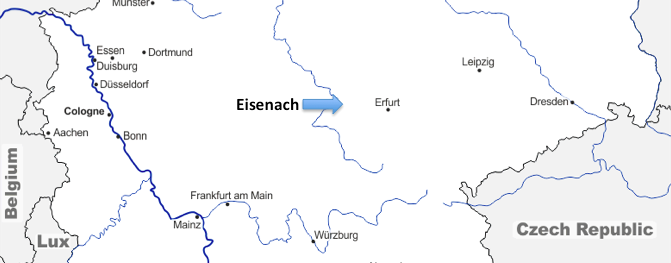
A European Journey #16 – Eisenach (Germany)
Johann Sebastian Bach
This week we are going to the region of Thuringia in Germany, where we will stop in the town of Eisenach.
The old town made of cobblestone streets, half-timbered houses or stone houses is very typical in this part of the world. There are also many churches to visit, such as the Nikolaikirche or the Georgenkirche.
Some Protestants may remember that the town is connected to the Reformation. It was in fact here that Martin Luther completed his high school education. It was also in the Wartburg castle, which overlooks the town, that Luther went into hiding after being excommunicated by the Roman Catholic church at Worms. It was in that castle that he also completed the German translation of the Bible.
But for this stage, we are going to the Frauenplan square. There we find a statue and a museum in honour of the other important figure of the town: Johann Sebastian Bach.
It was indeed in Eisenach that the man considered to be the father of modern music was born, on the 21st of March 1685. While we don’t know the exact place he was born, it is believed to have been near the current Bach house museum.
Nearly two centuries before his birth, in the time of Martin Luther, his great-great grandfather Veit Bach, also a Protestant, had been forced to flee his home country of Hungary to seek refuge in the region.
In addition to recovering the gospel of salvation, the Reformation also recovered church music and the singing of hymns. And this change would have a huge influence on the descendants of Veit Bach. His son Johann Christoph Bach (Johann Sebastian’s great grandfather) became the town and court organist of Eisenach. Musical activity was thus naturally passed on to his descendants.
The early life of Johann Sebastian Bach was not a very happy one. He lost his mother at an early age and then his father died when he was only ten years old.Thus he didn’t have the time to learn much music from his father. Left as an orphan, Johann Sebastian was now forced to leave Eisenach. Bach followed his brother Johann Christoph nearly 40 km away to the town of Ohrdruf, where he was an organist. It was with his brother that Johann Sebastian started to play the harpsichord.
Johann Christoph soon discovered the talent and passion that his brother had. Whenever he gave his brother a piece of music, he learned it very quickly and demanded other pieces to learn. This situation did not last long, however, as Johann Christoph soon died.
Now Johann Sebastian was left alone and again forced to leave, this time to the town of Lüneburg, further in the North. There he entered the choir of St Michael’s convent. He didn’t sing for long, however, as his biography records that he soon lost his voice. This is why he started to play the harpsichord and the organ. Often, Johann Sebastian Bach would travel to various towns to listen to famous musicians of his day, such as the organist Johann Adam Reinken in Hamburg, the French band of the Duke of Celle or the organist Dietrich Buxtehude in Lübeck.
His incredible talent was quickly noticed, which led him to being appointed court organist in Weimar at the young age of eighteen. This was the beginning of a career that led him to various places across Germany, including Arnstadt, Mühlhausen or Leipzig. Then in the year 1723, when he was 37 years old, Bach was appointed Director of Music and Cantor at St Thomas School in Leipzig, a position that he kept for 27 years, that is,until his death.
Although he was highly successful and popular, history tells that he remained humble.No doubt, this was a fruit of his faith in Christ. As Martin Luther had taught, Bach believed that music was an act of worship to God. He also encouraged his pupils to commit their talents to the Lord Jesus Christ. His handwritten manuscripts often contained abbreviations such as ‘S.D.G.’, short for Soli Deo Gloria (Glory to the only God), ‘J.J.’ for Jesu Juban (Help me Jesus) or ‘I.N.J.’ for In nomine Jesus (In the name of Jesus).
During his career, Bach composed at least 295 cantatas (vocal composition with instrumental accompaniment) for the yearly cycle of church music. It is believed that 265 of them were composed within 20 years of his time in Leipzig. This would mean that he might have composed a cantata each month during that period of time. This was an incredible achievement, considering that each of these were masterpieces. Sadly, we only have little over two hundred of them left today.
Bach also wrote many books that had been used to teach music ever since. Through these, Johann Sebastian Bach influenced the later development of European classical music.
And still today, his most celebrated oratorio, St Matthew Passion, in which the chapters 26 and 27 of the Gospel of Matthew are put into music, is listened to by millions of people around the world, in concert halls, through CDs or digital format, particularly around Easter time.
See you next week somewhere else in Europe
Cédric Placentino
Schuman Centre convener for Italian and French Europe
Follow A European Journey here.

This Post Has 0 Comments